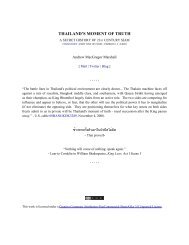THAILAND'S MOMENT OF TRUTH - ZENJOURNALIST
THAILAND'S MOMENT OF TRUTH - ZENJOURNALIST
THAILAND'S MOMENT OF TRUTH - ZENJOURNALIST
You also want an ePaper? Increase the reach of your titles
YUMPU automatically turns print PDFs into web optimized ePapers that Google loves.
ut the position of the body pointed to assassination. No verdict was possible on the<br />
evidence submitted. Investigations are to continue.<br />
The commission received the report of a medical committee of 20 who were said to<br />
be unanimous only on the cause of death – a bullet entering the forehead and passing<br />
out at the back of the skull. The muzzle had been held within five centimetres (less<br />
than two inches) of the forehead, it was stated. (Reuters, Siamese King’s Death<br />
Suicide or Assassination, November 1, 1946]<br />
The initial public statements that King Ananda accidentally shot himself had been made at<br />
the behest of Rangsit and the royalists, who refused to countenance any public suggestion<br />
that Rama VIII had committed suicide. The princes, politicians and officials who gathered<br />
downstairs at the Barompiman Hall on June 9 to debate how to break the news to the people<br />
of Thailand were well aware that suicide was a far more likely than a scenario in which<br />
Ananda had been inspecting a Colt .45 while lying on his back in bed without his spectacles<br />
on, somehow pressed both the trigger and the safety catch, and shot himself in the head<br />
by mistake. But now that doctors had stated the obvious – the accident explanation was<br />
bogus – princes and Democrat Party politicians seized on this to accuse Pridi of a highly<br />
suspicious cover-up. It had, of course, been a cover-up, but it was a cover-up the royalists had<br />
demanded.<br />
However, it was a shock that forensic and medical evidence suggested that even suicide<br />
was highly unlikely, and that King Ananda had most probably been murdered. This made<br />
the political atmosphere even more feverish. The government failed to formally respond<br />
until November 28, when a cabinet sub-committee recommended that a whole new police<br />
investigation into the death should be held. As Associated Press reported:<br />
The action was tantamount to the rejection of a report by an official commission<br />
of inquiry that concluded that the young king died as a result of either suicide or<br />
assassination. [Associated Press, New Study of King’s Death, November 28, 1946]<br />
The police took another seven months to set up an investigation, and by November 1947,<br />
more than 16 months after Rama VIII was shot dead in his bed, they had failed to make any<br />
apparent progress in solving the case.<br />
To many people, this lack of urgency appeared clear evidence that Pridi and the government<br />
had something to hide. They had falsely claimed Ananda’s death was an accident. And now<br />
that an independent commission, with expert medical advice, had declared it was almost<br />
certainly murder, they were failing to make any real effort to investigate.<br />
Three broad groups were fighting over power during this period: militarists, royalists, and<br />
pro-Pridi leftists. The royalists – including most senior princes and the Democrat Party – were<br />
determined to rebuild the power and prestige of the palace, but were having limited success<br />
making any headway at the polls: in elections held in July 1946, Pridi’s supporters had won<br />
57 seats and the Democrats only 11. The militarist clique around Phibun – which by no means<br />
contained all members of the military - had been disgraced by his actions during the war.<br />
Phibun had also repeatedly shown himself to be hostile to the palace when he had been in<br />
power – he wanted to elevate himself to the position of Thailand’s fascist leader, and render<br />
royalty obsolete. Pridi, meanwhile, had done his best to safeguard the status of the palace as<br />
the symbolic centre of Thailand’s constitutional monarchy, although he had no inclination<br />
to grovel to the royals and did not support major political power being restored to unelected<br />
Chakris. He had protected the palace against Phibun’s efforts to eclipse it. And now he was in<br />
the ascendancy and was overseeing genuine progress towards democracy.<br />
This proved unacceptable to the princes and the Democrat Party. They still harboured<br />
40




